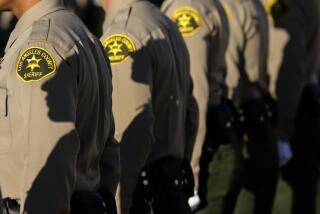‘Ghost stops’: Lieutenant claims LAPD officials were warned about troubled gang unit

- Share via
- A lawsuit filed by LAPD Lt. Mark Garza alleges department officials unfairly punished him for misconduct by officers under his command.
- Garza led an anti-gang unit in the San Fernando Valley whose members are accused of trying to cover up illegal traffic stops and thefts from motorists.
- Garza claims he tried to report so-called “ghost stops,” where officers turned off their body-worn cameras, but was ignored until the scandal became public.
A Los Angeles police lieutenant has filed a legal claim against the city, alleging his superiors ignored his warnings about misconduct in an anti-gang unit until it became a public scandal, leading to him facing termination.
The claim, which typically serves as the precursor to a lawsuit, was brought this month by Lt. Mark Garza. It’s the first litigation being pursued by a former member the Mission Division gang unit, whose officers came under investigation last year over allegations they illegally stopped and searched vehicles and stole from people they pulled over.
Garza, who was in charge of the unit, said he reported his suspicion in June 2023 that some of his officers were conducting “ghost stops,” which meant their actions could go unnoticed because they didn’t document the encounters or turn on their body-worn or dashboard cameras and never informed police dispatch of where they were.
At that time, Garza said, the department’s body camera policy required supervisors to review only footage related to “complaints, use of force and pursuits.” Meanwhile, audits at the bureau level were limited in scope, with only two videos per unit reviewed randomly every 30 days or so. Without more robust checks, the lieutenant argued, it was possible for misconduct by his unit to fly under the radar.
As he dug into the issue, Garza said he learned that videos of officers breaking the rules were deliberately excluded from audits — ensuring almost perfect results every time.
He said he learned that auditors at the department’s four geographic bureaus were under orders to exclude incomplete body camera videos from their reviews — creating the potential for officers to intentionally delay turning on their cameras because they knew partial recordings would be overlooked. Video checkers were also being specifically told “not to identify problems” by gang officers, he alleged.
Garza said one auditor told him: “We‘re only looking for good things.”
Before he became executive director of the L.A. Police Commission, Django Sibley was a beat cop in Hull, Britain. Like most of his colleagues, he didn’t carry a gun.
Garza said he “believes he was set up to fail and then held accountable for the failure.” The department tried to “cover up its own flawed policies,” he alleged, and punished him in retaliation for pointing out these deficiencies as the scandal was going public.
The city attorney’s office didn’t respond to an email about the case sent Friday. An LAPD spokesperson declined to comment. An attorney for Garza didn’t respond to inquiries.
The cloud over Garza’s unit first became known in August 2023, when The Times reported that internal affairs investigators had taken the rare step of obtaining a warrant to search officer lockers in the Mission Division station. Department officials said the FBI was also looking into the matter.
With his officers accused of breaking the law and trying to cover it up, Garza was relieved of duty earlier this year. He could be fired after a board of rights hearing next August. His former boss, Mission Capt. James “JT” Townsend, is also facing termination, along with Sgt. David Gomez, and several former gang officers.
One of the officers, Alan Carrillo, has been criminally charged with stealing a knife and brass knuckles from motorists in separate stops in April and June 2023. He has pleaded not guilty and a preliminary hearing is set for next month.
Garza said he first noticed the questionable stops after someone complained that a Mission gang officer had thrown a cup of iced coffee at a teenager. Garza said he was told there was no record of the encounter, but when he reviewed body camera footage from earlier that day, he found video of a traffic stop in which a cup of coffee could clearly be seen. As he continued watching, he heard someone say, “you didn’t give me my ID back,” just before both officers turned off their cameras, according to the claim.
The next day, Garza said, he reported the incident to Townsend, the division’s captain, who instructed him to remove the two officers from the field.
Although Garza was eventually placed on home leave and relieved of his badge and gun, he said higher-ranking officers involved were allowed to remain on the job, and several were promoted. One, he said, was Capt. Matthew Plugge, who was “even moved to a better position,” while the investigation was ongoing.
“This is classic differential treatment,” the claim says.
A lawsuit by former SWAT officer Timothy Colomey accused leaders of the LAPD tactical unit of working to conceal unlawful killings and retaliating against him when he spoke to internal investigators.
The allegation that LAPD’s command staff only responds to crises that publicly embarrass the department fits a perception widely held among front-line officers and mid-level supervisors, according to other recent lawsuits and public comments by police union officials.
Similar finger-pointing occurred in the Rampart scandal, which broke in 1998, when disgraced Det. Rafael Perez told internal investigators that he and fellow officers routinely planted evidence, shot some people without provocation and framed others for crimes they did not commit. Several sergeants later sued the city, saying they were being made to take the fall for the department’s misdeeds.
In a later controversy, members of the LAPD’s vaunted Metropolitan Division were accused of mislabeling people as gang members. One of the officers under suspicion alleged in a lawsuit that commanders had for years enforced a de facto quota system that rewarded cops who identified and arrested alleged gang members and punished those who didn’t, creating an incentive for officers to level false allegations.
In Garza’s case, he said that after discovering more “ghost stops,” he tried several times to bring the issue up with department higher-ups. Garza said in his claim that he was “taken aback” by the dismissive response he received from his superiors, who took no immediate action.
He argued that the department was following a similar playbook from past scandals: protect senior-level officials “while vilifying lower-ranking employees, and then move on.”
An internal LAPD report that was published after the scandal broke suggested that body camera misuse is more widespread than the department is letting on publicly. Department officials have tightened their camera policy, and raised the possibility of using AI to review the countless hours of footage that goes unseen each month.
The list of chief candidates reveals who among the LAPD’s top brass angled for the position and sheds light on heavy politicking behind the scenes.
Garza sued the department once before, alleging that he was transferred and otherwise retaliated against after he reported misconduct, ranging from overt homophobia and racial bias exhibited by certain officers to an allegation that a West L.A. captain rode in a vehicle with fake license plates to avoid paying highway tolls. The case was settled in 2015.
The L.A. County district attorney’s office has identified as many as 350 criminal cases that are potentially compromised because they relied on the testimony of or evidence gathered by Garza’s unit.
Prosecutors have filed records that show even the case against Carrillo, the officer facing criminal charges, has been complicated because potential witnesses who served with him have been included on a list of officers with known credibility issues.
More to Read
Sign up for Essential California
The most important California stories and recommendations in your inbox every morning.
You may occasionally receive promotional content from the Los Angeles Times.













